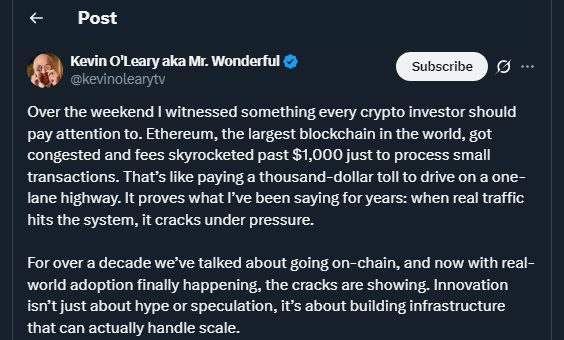TL;DR
- Shark Tank investor Kevin O’Leary criticized Ethereum, claiming it “cracks under pressure” after gas fees surged above $1,000 during heavy network traffic.
- He compared Ethereum to a one-lane highway, questioning its scalability as real-world adoption grows.
- Ethereum developer Adriano Feria responded, explaining that Layer 2 solutions handle most transactions while Layer 1 prioritizes security and institutional settlement, highlighting Ethereum’s robust ecosystem.
Kevin O’Leary, Canadian businessman and TV personality, has raised concerns over Ethereum’s ability to handle increasing blockchain activity. In a recent post on X, he said he witnessed significant network congestion, leaving users paying over $1,000 in gas fees for relatively small transactions. The spike in fees, according to O’Leary, coincided with heightened market volatility and a surge in retail transactions, highlighting the network’s limitations under stress.
Investor Highlights Real-World Network Pressure
O’Leary described Ethereum as a single-lane highway struggling under heavy traffic, comparing transaction congestion to a toll booth bottleneck. He argued that the recent surge exposes Ethereum’s weaknesses as adoption rises and more users interact with the blockchain in real-world scenarios.
“If you’re buying something for $1.50 and have to pay a thousand to move it, that’s a clear sign of stress,” he said.
He also noted that such congestion could deter smaller investors from using Ethereum for everyday transactions, potentially slowing mainstream adoption temporarily.
Developer Emphasizes Layer 2 Solutions And Security
Ethereum developer Adriano Feria countered that Layer 1 is designed as a final settlement layer, focusing on security, neutrality, and auditability. Feria explained that most high-frequency transactions are handled by Layer 2 rollups, capable of processing hundreds of transactions per second.
“Institutional users rely on Ethereum’s security and reliability, not just raw throughput,” Feria stated, pointing to ongoing usage by Coinbase, BlackRock, Visa, and Sony.
Feria also highlighted that Ethereum’s infrastructure continues evolving, with upcoming protocol upgrades expected to further improve efficiency without compromising security.

Despite O’Leary’s criticism, Ethereum’s broader ecosystem continues to expand. Layer 2 solutions are scaling rapidly, offering faster, cheaper transactions while maintaining the integrity of Layer 1. With billions in stablecoins, tokenized funds, and real-world assets now settled on Ethereum, the network remains a key player in institutional adoption.
O’Leary also linked the congestion to increased on-chain adoption spurred by legislative initiatives such as the Genius Act. He suggested that as blockchain payments gain traction in the real world, scalability will remain a visible challenge, but one that the Ethereum ecosystem is actively addressing through its layered infrastructure.











